Related Research Articles
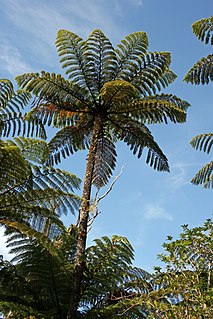
Cyathea is a genus of tree ferns, the type genus of the fern order Cyatheales.
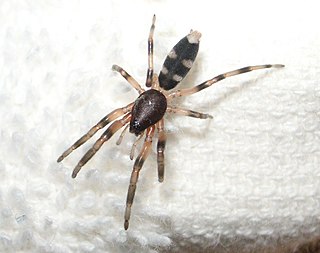
Lamponidae is a family of spiders first described by Eugène Simon in 1893. It contains about 200 described species in 23 genera, most of which are endemic to Australia, with the genus Centrocalia endemic to New Caledonia, and two Lampona species also occurring in New Zealand where it is commonly known as the "White Tail" spider. Lampona papua is endemic to New Guinea, where two otherwise Australian species also occur.

Mauremys is a genus of turtles in the family Geoemydidae.
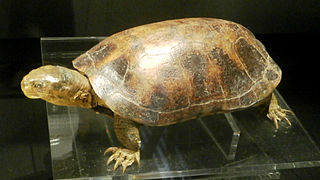
The yellow pond turtle, is a medium-sized, semi-aquatic turtle in the family Geoemydidae. This species has a characteristic broad yellow stripe extending behind the eye and down the neck; the carapace ranges in color from grayish brown to brown and the plastron is yellow or orange with black blotches along the outer edges. It is found in East Asia, ranging from central Vietnam, north through the coastal provinces of south and central China. Additional insular populations are found in Taiwan, Hainan, the Ryukyu Islands, and Japan. The Japanese populations are believed to have been introduced as a result of imports from Taiwan.
Omphalotropis mutica is a species of minute salt marsh snail with an operculum, a terrestrial gastropod mollusk, or micromollusk, in the family Assimineidae. This species is endemic to Palau.
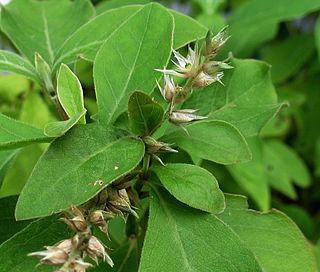
Achyranthes mutica is a species of plant in the family Amaranthaceae. It is endemic to Hawaii. Its natural habitats are dry forests and subtropical or tropical dry shrubland. It is threatened by habitat loss.
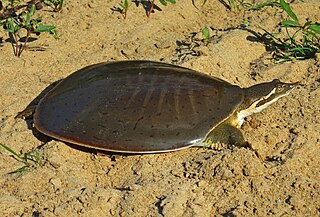
The smooth softshell turtle is a species of softshell turtle of the family Trionychidae. The species is endemic to North America.
Azumamorula mutica, common name the smooth ricinula, is a species of sea snail, a marine gastropod mollusk in the family Muricidae, the murex snails or rock snails. It is the only species in genus Azumamorula.
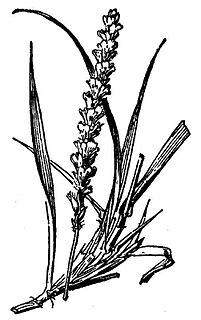
Pleuraphis mutica is a species of grass known by the common name tobosa, or tobosa grass. It is native to Northern Mexico, and the Southwestern United States, in Arizona, New Mexico, Oklahoma, and Texas.

Caprella mutica, commonly known as the Japanese skeleton shrimp, is a species of skeleton shrimp. They are relatively large caprellids, reaching a maximum length of 50 mm (2.0 in). They are sexually dimorphic, with the males usually being much larger than the females. They are characterized by their "hairy" first and second thoracic segments and the rows of spines on their bodies. Body color ranges from green to red to blue, depending on the environment. They are omnivorous highly adaptable opportunistic feeders. In turn, they provide a valuable food source for fish, crabs, and other larger predators. They are usually found in dense colonies attached to submerged man-made structures, floating seaweed, and other organisms.

Pleiocarpa mutica is a plant in the family Apocynaceae.
Tethystola inermis is a species of beetle in the family Cerambycidae. It was described by Galileo and Martins in 2001 and is known to be from Venezuela.
Tethystola unifasciata is a species of beetle in the family Cerambycidae. It was described by Galileo and Martins in 2001. It is known from Peru.
Tethystola brasiliensis is a species of beetle in the family Cerambycidae. It was described by Breuning in 1940. It is known from Brazil.
Tethystola cincta is a species of beetle in the family Cerambycidae. It was described by Martins and Galileo in 2008. It is known from Bolivia.
Tethystola dispar is a species of beetle in the family Cerambycidae. It was described by Lameere in 1893. It is known from Venezuela.
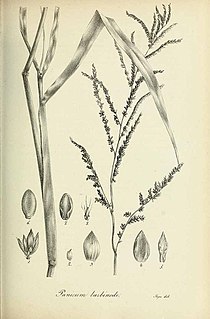
Brachiaria mutica is a species of grass known by the common names para grass, buffalo grass, Mauritius signal grass, pasto pare, malojilla, gramalote, parana, Carib grass, and Scotch grass. Despite its common name California grass, it does not occur in California; it is native to northern and central Africa and parts of the Middle East, where it is cultivated for fodder. It was introduced elsewhere and it is now cultivated throughout tropical regions of the world for this purpose.

Pterostylis mutica, commonly known as the midget greenhood, is a plant in the orchid family Orchidaceae and is endemic to Australia, occurring in all states but not the Northern Territory. There is a rosette of leaves at the base of the flowering stem and up to fifteen pale green flowers which have a sensitive labellum.

Haworthia mutica is a species of succulent plant native to South Africa's Cape Province. Very similar to, and often confused with, types such as Haworthia retusa, the species has blunt, triangular shaped leaves that are typically striated. In the wild it rarely offsets, though clones in cultivation may do so readily. The variety H. mutica var nigra is similar but with darker leaf color.
Dorel Mutică is a Romanian former professional footballer and currently a manager. He played mainly as a defender for teams such as: UTA Arad, Rapid București, CSM Reșița, Steaua București or Lombard Pápa, among others. After retirement Mutică started his career as a football manager, occupying this position at fourth tier sides Frontiera Curtici and Progresul Pecica, both from Arad County, where Mutică settled.
References
- ↑ BioLib.cz - Tethystola mutica. Retrieved on 8 September 2014.
| This Apomecynini article is a stub. You can help Wikipedia by expanding it. |